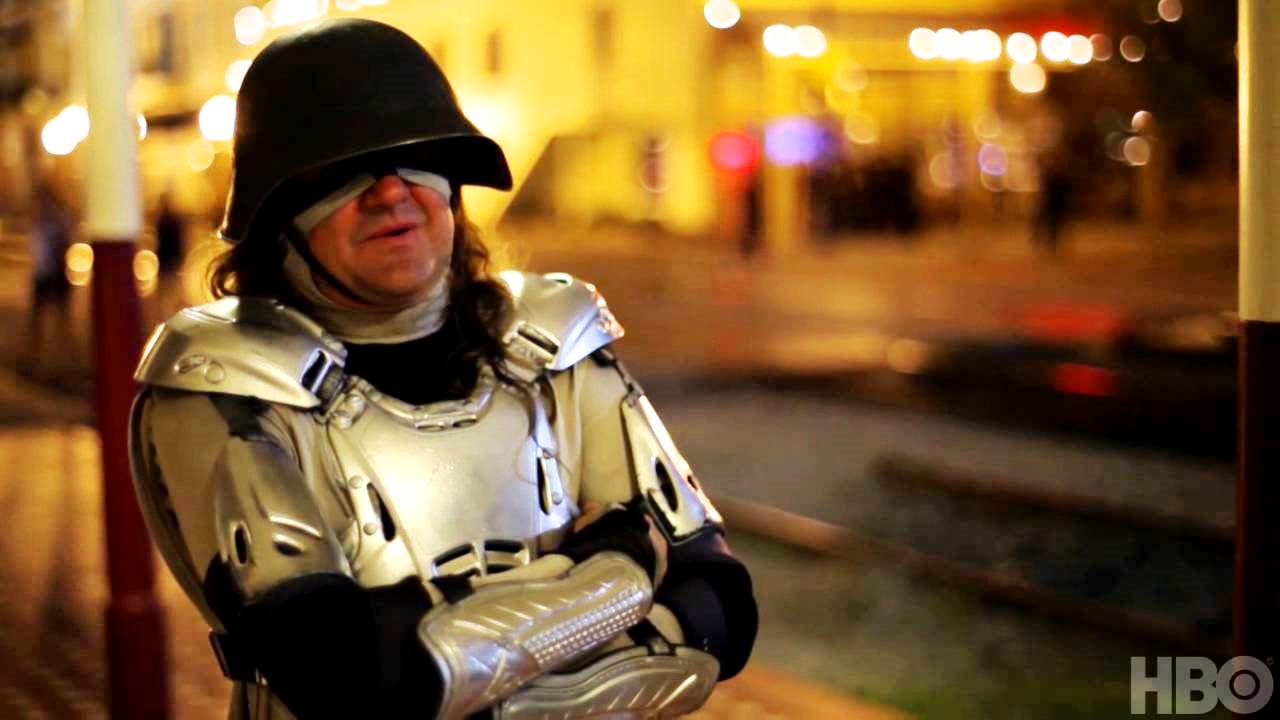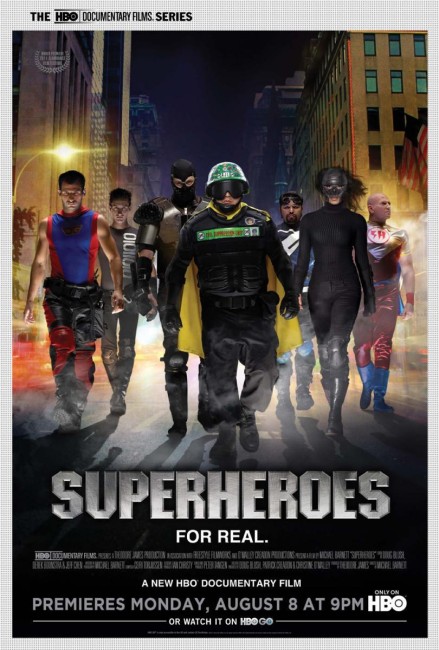USA. 2011.
Crew
Director/Photography – Michael Barnett, Screenplay – Michael Barnett & Theodore James, Producer – Theodore James, Music – Cieri Torjussen, Animation – Syd Garon, Comic Designs – Titmouse Inc.. Production Company – Theodore James/Freestyle Filmworks/O’Malley Creadon Productions.
Superheroes have been massive on the big-screen throughout the 00s, in particular with the huge success enjoyed by the numerous adaptations of various Marvel Comics characters and to a lesser extent those from DC. These have resulted in the inevitable parodies. In more recent years, these have given way to a spate of films that deflate superheroic ideals by featuring superheroes that have no powers and are deluded or naively idealistic about what they are doing with the likes of Special (2006), A Man Who Was Superman (2008), Defendor (2009), Griff the Invisible (2010), Kick-Ass (2010) and Super (2010). (For a more detailed overview of the genre see Superhero Films). The natural out-thrust of these superheroes-without-powers films is Superheroes – a documentary that charts the exploits of people who are doing precisely that in the real-world, dressing up in superhero costumes and going out and fighting crime in their neighbourhoods, all despite their lack of any superpowers.
Welcome to the world of Real-Life Superheroes. I had no idea before this that such a phenomenon existed and Superheroes does a remarkable job of tracking down a surprising number of people around the USA (and one from Vancouver, Canada) who have all donned costumes of some variety and gone out to fight crime. The surprise is the number of people who are doing this – the film features interviews with some thirty of them. Some, although not all of the superheroes, operate behind masks – the film always refers to them by their alter egos as opposed to their real identity. The film is accompanied by a series of comic-panel animatics that illustrate several adventures the various superheroes recount.
The surprise about Superheroes is that is resists the opportunity to turn everything into a complete freakshow – compare, for example, its treatment up against that of the very similar Trekkies (1997), which made a play for the wackier aspects of Star Trek fandom. The various members of the New York Initiative even come out showing what they do with a peculiar kind of nobility. Certainly, some of the individuals do leave you a little worried about their grip on reality. There is the pudgy character of Mr Xtreme who dresses in an outfit with a flak helmet and joke store goggles, lives in a messy apartment overflowing with junk that he insists on referring to as the Xtreme Cave, claims to be doing research that consists of watching episodes of Mighty Morphin Power Rangers (1993-6) for inspiration, and that he represents the Xtreme Justice League even though this appears to have no members other than himself (although he does eventually obtain a single acolyte). We see him preparing for martial arts tournaments, including battering a training dummy in his kitchen with an alarming enthusiasm.
The most fascinating character in the film is Master Legend who patrols the streets of Orlando, Florida. Master Legend seems as much showman as he is crimefighter – we see him frequently stopping to chat up and admire women. He insists that having a supply of beer is an essential item in his equipment and stops off at a bar to have a drink and talk to several women at one point. (One would like to see a real-life uniformed police officer trying to get away with such while on duty). Master Legend is the only superhero interviewed who insists that he has real powers (almost all of the others place an emphasis on martial arts training) – at one point, we see him praying to The Almighty for a miraculous healing of a man in a wheelchair. Elsewhere the character of Super Hero makes the entirely unconvincing case that Master Legend has psychic insight due to the fact that he predicted the outcome of a paternity claim made against Super Hero.
There are a few occasions when Superheroes digs deeper in search of the psychological motivation for these characters – Mr Xtreme talks about how he was a victim of violent assault in his life, others about adopting their alter egos as a response to troubled upbringings. Master Legend even tells the story of how he donned a superhero costume to stand up to a school bully at the age of 8-9. One superhero, Fool King, tells the intriguing story of how he was a drug user, alcoholic and drug dealer and adopted superhero guise as a symbol of turning his life around. A psychologist is on hand to state that she believes they are not crazy – although never goes much deeper into explaining their need to play-act at being superheroes than that. Amid all of this, there is the obligatory interview with Marvel Comics guru Stan Lee who offers cautious criticism of the idea of real-life superheroes.

There is Lieutenant Andra Brown, an overly serious member of the San Diego police department, who is on hand to offer a critical side of the coin. Though she makes the points in a way that are overly pedantic, she does raise some effective questions. This being that the various superheroes are essentially enacting vigilante justice. It is, for example, not too difficult to go one step beyond the New York Initiative patrolling the streets and setting out to bait homophobes and rapists, not to mention look at the lengthy arsenal of weapons the various superheroes eagerly display, and think of Charles Bronson setting out to bait and shoot muggers on the streets of New York City in Death Wish (1974). As Andra Brown points out, they operate without any substantial knowledge of law, concern for people’s rights, and lack guidelines or professional standards, merely operate by their own assumptions as to what is right and wrong – certainly, we do see Dark Guardian making audio and video tapes of drug dealers before driving them off but that seems to be the sole occasion when we move beyond an individual’s moral belief in right into attempting an evidence-based set of assumptions.
On the other hand, the New York Initiative do make an undeniable case for what they are doing when they show a newspaper article that reveals the NYPD is turning down convictions in an attempt to manipulate crime statistics – one of the overriding beliefs that drive most of the superheroes seem to that the existing US law enforcement agencies are failing to fight crime adequately and that someone needs to do something about it. A number of the superheroes cite as inspiration the story of Kitty Genovese, the New York woman who was stabbed to death in 1964, while 38 people heard her screams but did nothing (although subsequent reality showed that these statistics were something manipulated by a newspaper looking for a sensationalistic headline).
Eventually, a certain truth does become apparent about these superheroes in that they are only tiptoeing around the periphery of dealing with crime and seem at best to be little more than neighbourhood watch teams in masks and capes but are ineffectual beyond that. As one cop says with undeniable dubiousness in his voice, “I think it is a good idea. But if he gets into trouble, he’s going to have to call us.” There does seem a certain failing when it comes to the superheroes’ ability to actually stop any crime. When Dark Guardian tries to drive away a drug dealer, the first thing the dealer does is laugh in his face and ask if he is a cop or has a warrant and then proceeds to ignore him. Similarly, when the New York Initiative pull over a drunk driver, their delight as having happened upon something is deflated when the NYPD fails to do anything except drive past after two phone calls.
Unlike their comic-book equivalents, these superheroes don’t seem to be saving the world and tackling super-villains and cosmic menaces, but dealing with very petty issues. Of the examples where we do see them in action, all that we get is the New York Initiative setting out to tackle would-be rapists and attackers but instead coming to the rescue of a hit-and-run victim (where Zimmer certainly demonstrates expertise as a trainee EMT) and confiscating the car keys of the drunk driver; or Mr Xtreme setting out to stop a serial groper (but never doing so) in Chula Vista, San Diego; and Dark Guardian driving away a neighbourhood drug dealer. Not exactly world-shattering crime solving.
Just when the scenes of the superheroes in action reveal them as at best people with good intentions operating under a naive idea of fighting crime by black-and-white comic-book dictates, the last section of the film shows the other side of the movement. Here we see various of the superheroes engaged in charity work from taking collections of children’s toys to the families of the poor at Christmas to distributing care packages of food, warm clothing, water and the like to the homeless living on the street – in the case of Life, it appears that he is simply offering human companionship. Moreover, it would appear that these works of charity are being funded out of their own pockets. In the scenes where several of the superheroes gather at the San Diego Comic Con and do charity work among the homeless nearby, it is the down-and-outs who offer the most honest and heartfelt appreciation of the good that the superheroes are doing. While the film makes you raise an eyebrow and wonder about the sanity and motives of some of these people at the outset, this section eventually finds something peculiarly ennobling in what they are doing.
Director Michael Barnett has gone on to make a number of other documentaries including Becoming Bulletproof (2014), a Western with disabled, The Mars Generation (2017) about aspiring NASA astronauts and Changing the Game (2019) about transgender athletes.
Trailer here


